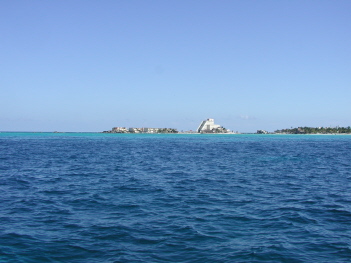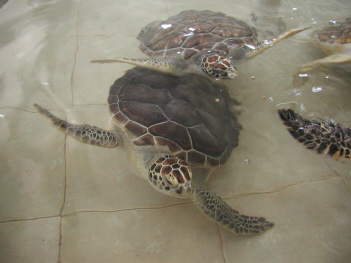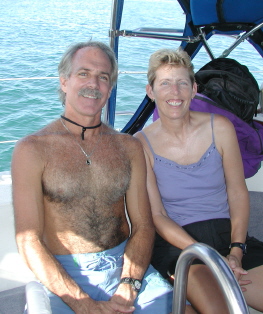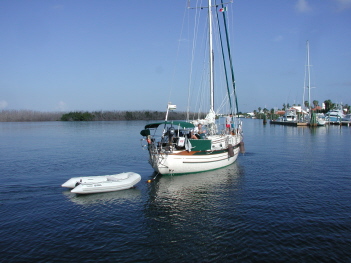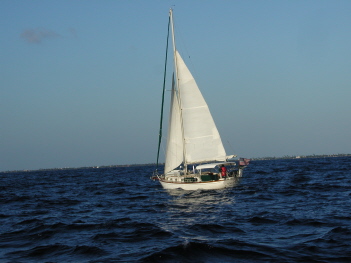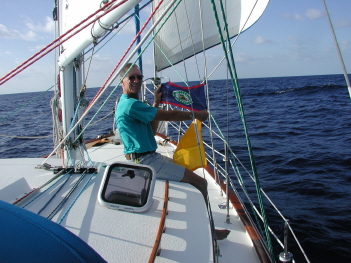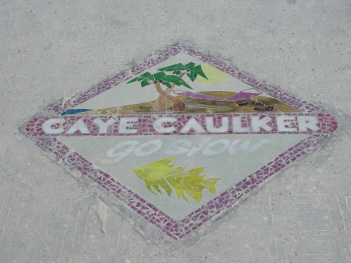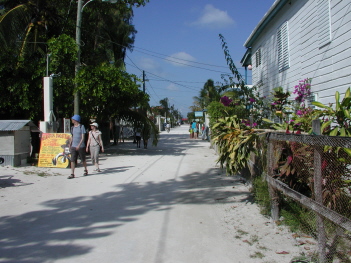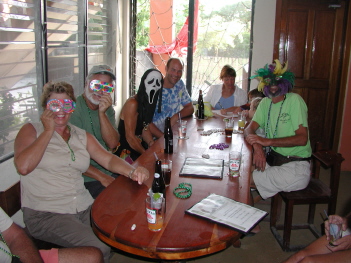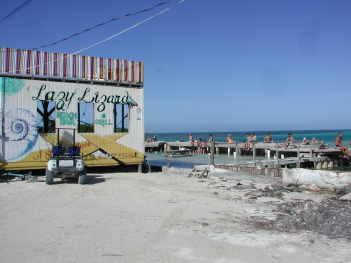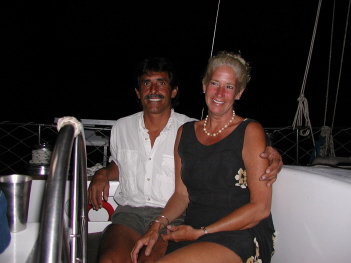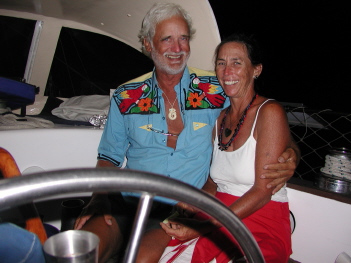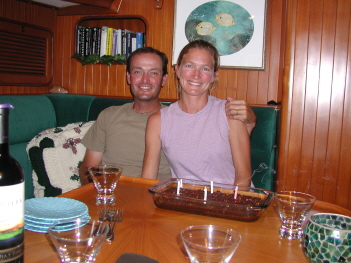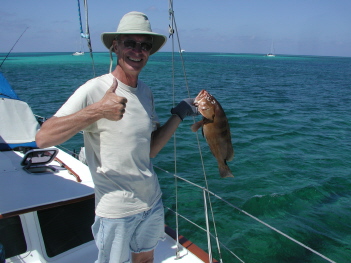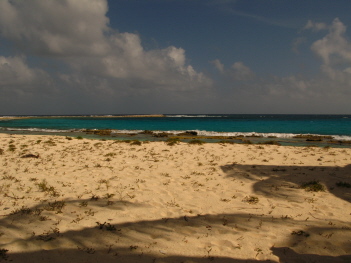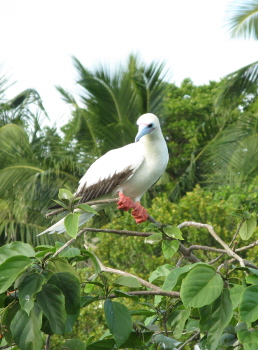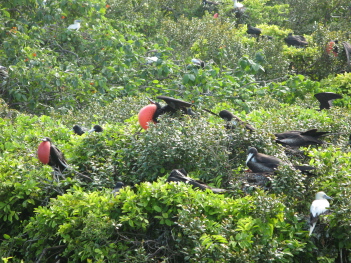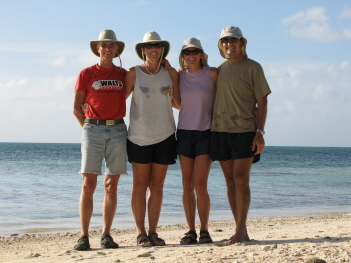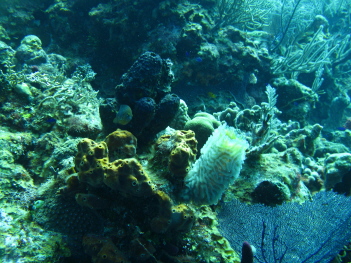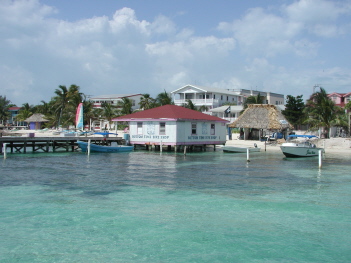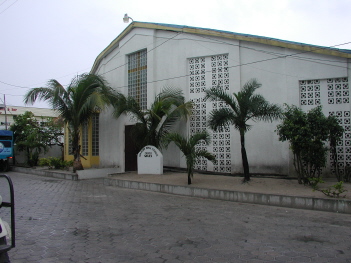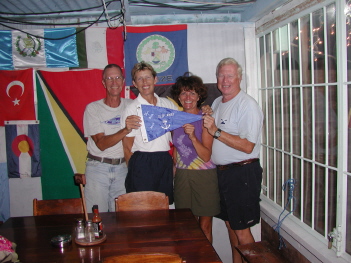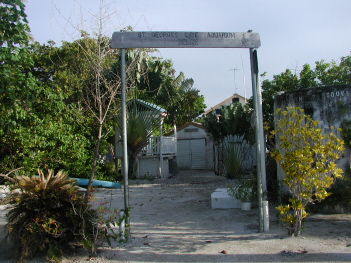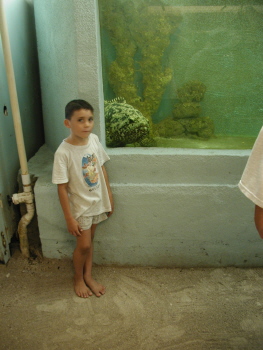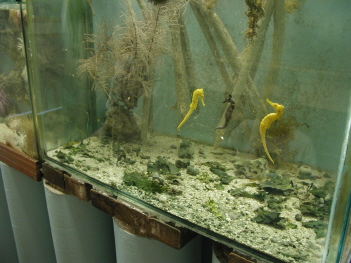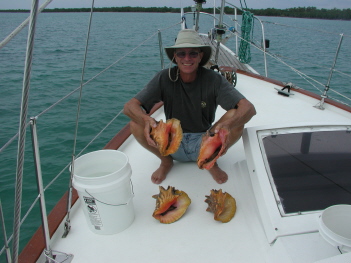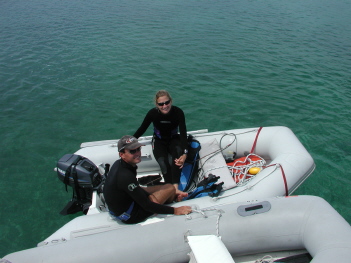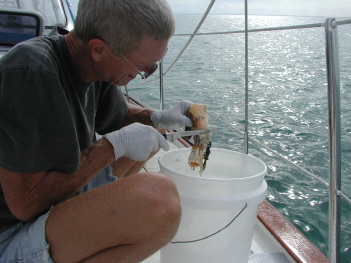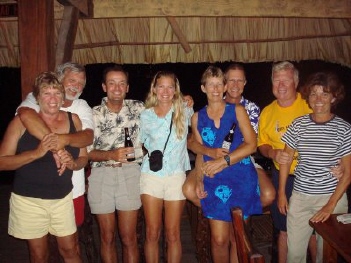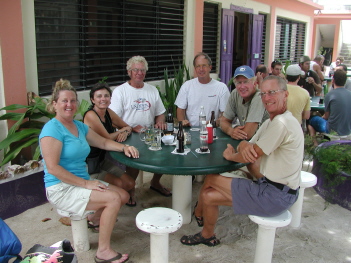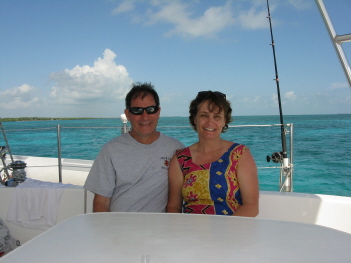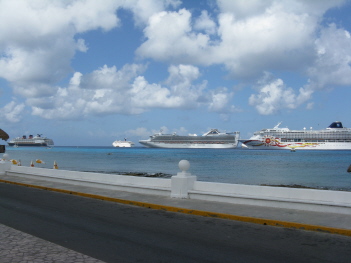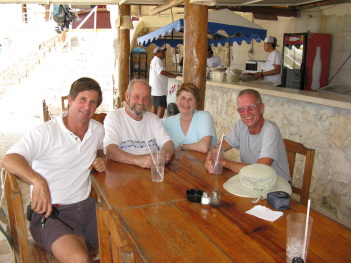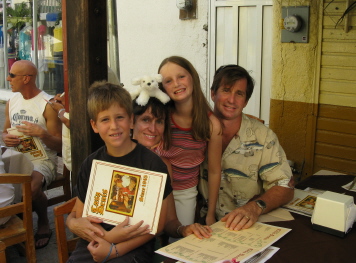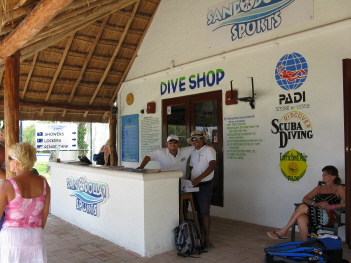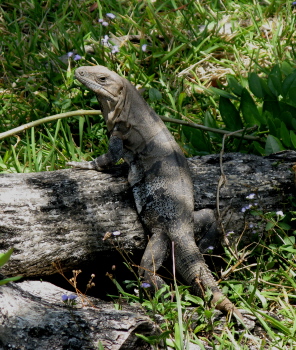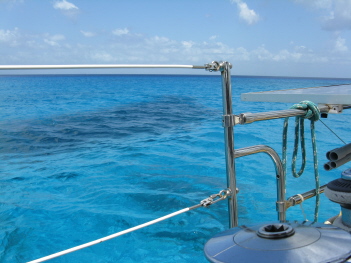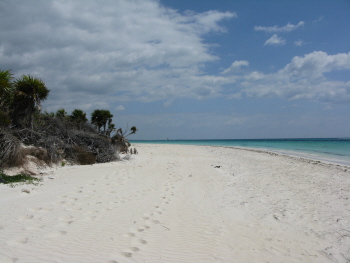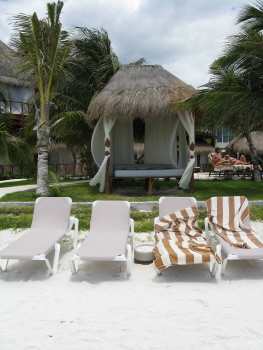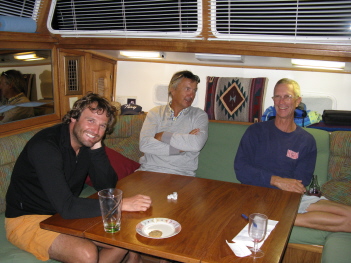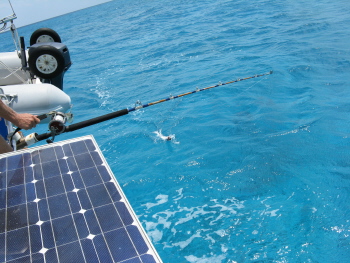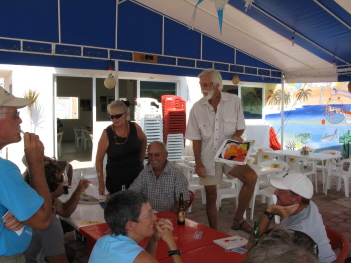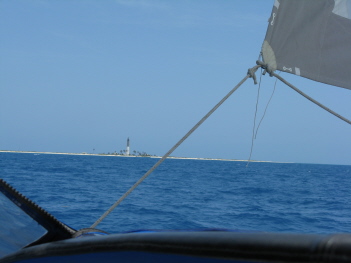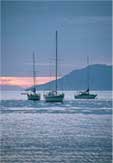
Current Location
(enter callsign KG6NNZ)
Logbook: Caribbean Mexico and Belize - January to April 2008
After spending the better part of last summer and fall working on boat projects, our goal for this winter was to sail to the Caribbean and have some fun. We were especially looking forward to snorkeling and scuba diving in the beautiful blue waters of the Caribbean. We spent four months visiting southern Mexico and Belize, and although there was not enough time to see it all, we felt like we got a good taste of cruising in this area.
We spent a lot of time in the water this winter. We made some new cruising friends and ran into a few folks we met last year, and we shared some wonderful times. With consistent Caribbean trade winds, we were almost always able to sail between anchorages, which not only made the passages more enjoyable, but also resulted in a nice savings considering the high cost of fuel in Belize. We learned more about sailing Slip Away this past winter than we had in the previous three years along the Pacific Coast, where we often had to motor between anchorages due to lack of wind. Overall the weather was extremely pleasant - most days temps were in the low to mid 80's F, and the water temperature was consistently 80 degrees F. We were occasionally reminded that it was winter when cold fronts with strong north winds (called "northers") blew through. Fortunately, our weather forecasters always gave us enough notice of these weather systems so we could find sheltered anchorages.
Jan did some traveling in this area in the past, but it was a long time ago, so most of it has changed significantly. The growth of tourism and the corresponding development was somewhat overwhelming. Cancun and the whole Yucatan area looks nothing like what it did when Jan worked at the Club Med there in 1986. She first traveled in Belize in 1992, and much of it, too, was almost unrecognizable.
Passage from Big Pine Key, Florida, to Isla Mujeres, Mexico (1/8-1/11, 364 nm, 71½ hours). The morning of our departure from Big Pine Key, a boat by the name of Sea Tryst with Bob and Maggie aboard called us on our SSB/marine radio. They heard us asking for weather information on the radio and wanted to get in touch with us since they were also headed to Isla Mujeres. We were really glad to get their call because prior to hearing from them, we thought we would be doing the passage alone. Having a buddy-boat on a multi-day passage is an added safety feature, and it's just nice to have someone to call on the radio to say "Hi." Sea Tryst, too, was happy to find a boat heading in the same direction, especially Maggie, since this was her first multi-day passage. We departed late Tuesday afternoon from Big Pine Key, and Sea Tryst left on Wednesday morning from Key West. We were never in sight of one another during our passage, but we kept in touch via the radio. We finally met each other in person when we reached Isla Mujeres, and over the next couple of months, we enjoyed lots of good times together in Mexico and Belize.
When we left the anchorage at Big Pine Key, we ran our engine for about 1½ hours to weigh anchor, get out of the harbor and top off the batteries. We then shut down the engine, and it stayed off for the better part of the next three days. We had pleasant sailing breezes (10 to 20 knots of wind from astern) for almost 3/4 of the trip. The wind died toward the end of our passage, so we needed to motor at that point, but the timing was quite good because we were then crossing the Yucatan Straits with calm seas. The Yucatan Straits have a very strong north-setting current and can sometimes be rough. We did hit a squall as we crossed the Yucatan Straits, but it had very little wind in it, just some rain, which gave Slip Away a nice washing. There was no moon during this passage, which made for great stars, but the nights were really dark. We expected to run into quite a bit of adverse current on this passage, but were pleasantly surprised that it wasn't as bad as anticipated. We even had a slight favorable current (about 1/2 knot) the first day of our passage. We calculated the adverse current cost us about 4 hours total, which is practically nothing on a three-day passage.
While underway, we checked in twice a day via the SSB radio with Sea Tryst and also the Northwest Caribbean Net, which kept track of us and made sure we arrived safely. The Northwest Caribbean Net is an hour-long morning SSB radio program which cruisers use to facilitate communication and share information on subjects like good and bad anchorages, questions about checking in with countries' officials, security concerns and other items of interest, and it has also been instrumental in assisting with emergencies. While we were underway, the Northwest Caribbean Net was looking for volunteers to serve as Net Controller (hosting the Net one day each week), and Rich volunteered Jan. She had served as a Net Controller for the Amigo Net in Mexico and the Pan Pacific Net in Central America and enjoyed it, and we found it was a great way to meet people.
| Mexico We developed a strong bond with Mexico after spending two and a half years on its Pacific Coast. Each time we return to this country, it feels a little like coming home. Although the Caribbean Coast is quite different from the Pacific, there are many similarities. We love the Mexican people, the food and the ambiance. The Yucatan was once the domain of Mayan civilizations, but today it is best known as a destination for a beach vacation. In the 1970's, Mexico's tourism department targeted Cancun for development, and they hit a gold mine. Today, the area attracts over two million visitors every year. Although it's disappointing to see this coast so over-developed, it's understandable how it happened, because the white beaches and clear blue Caribbean Sea are stunning. Isla Mujeres (1/11-1/27). One of the best anchorages along Mexico's Caribbean Coast is at Isla Mujeres, which is an island six miles across the channel from Cancun. Although Isla Mujeres has seen significant development in the past 30 years, it's been more controlled, and it somehow managed to avoid the frantic pace that has overtaken life across the channel. We stopped at Isla Mujeres last Spring as we headed north from Panama to Key West, but we were only here a couple of days, so we didn't get to see or enjoy much of it. We spent over two weeks here in January, and the time flew by quickly. |
|
When we got to Isla Mujeres, one of the first things we did was get in touch with Paul Vinyard, a friend from Jan's Club Med days. Paul and Jan taught water-skiing together at the Club Med in Cancun in 1986. After Cancun, Paul continued working at Club Med in a few other locations, then returned to work at the Club in Cancun for a second time, and after that, he made Cancun his home. He presently owns a very successful propeller shop in Cancun. We got in touch with Paul through another cruiser last year, but since our stay was so short, we missed seeing him, but we let him know we'd be back. We saw Paul several times while we were in Isla Mujeres this time, and he and Jan caught up with where their lives had gone over the 22 years since they'd last seen one another. One afternoon, Paul brought over a couple of scrapbooks with some old photos from the Club Med days, and they laughed and reminisced about old friends and good times.
While in Isla Mujeres, we also needed to take care of some medical appointments. We've found the care provided by doctors and dentists in Latin America to be excellent and much cheaper than in the U.S., so we got our teeth cleaned and did a couple other annual checkups. We were especially impressed by the dermatologist we visited in Cancun. He used an electronic microscope connected to a laptop computer to look at our skin. This was the most thorough screening we ever had by a dermatologist (and the office visit and exam cost $45/person).
We did some exploring on Isla Mujeres and really enjoyed our visit to their turtle farm, which protects turtle breeding grounds and provides protection for hatchlings for a year before releasing them into the wild. We also met some new cruising friends - Jon & Heather on Evergreen, Rodney & Katrina on Angelina and Bob & Maggie on Sea Tryst. All were planning to cruise in the same general area as us for the winter, so we knew we were in for a good time.
|
|
|
|
After a couple of weeks, with our doctor appointments done and a favorable weather window, we headed south to Belize.
Passage from Isla Mujeres, Mexico, to San Pedro, Ambergris Cay, Belize (1/27-1/29, 219 nm, 48 hours). The night before we left Isla Mujeres for San Pedro, we went out for pizza with our friend Paul. When we got back to the boat, Jan wasn't feeling well, and in the middle of the night, she woke up feeling worse (we'll skip the details). She and Rich shared a pizza for dinner, and Rich was fine, but it appeared she had food poisoning. In the morning, we debated putting off our departure, but the weather window was open, and Jan was feeling somewhat better, so we decided to go for it.
We traveled in company with Rodney and Katrina on Angelina, and we were always within sight of one another. Conditions were great on the passage - we sailed 43 of the 48 hours underway; winds were mostly 10-15 knots with a few hours of 15-20; and seas were pretty good, although sometimes a bit rolly due to the strong currents in this area. Jan felt queasy for most of the trip and took Stugeron (seasickness medication), which made her feel better but sleep a lot, so Rich covered some extra hours on watch.
|
|
|
| Belize The country of Belize covers an area of 8,900 square miles (23,000 square kilometers), which makes it slightly smaller than the state of Massachusetts. Coastal Belize is tropical lowland, but there are mountains in the interior. Belize's coast is lined by the longest barrier reef in the Western Hemisphere, the second longest in the world after Australia's Great Barrier Reef. Numerous mangrove Cays (pronounced "keys") sit along the barrier reef. Beyond the barrier reef, three of only four coral atolls in the Western Hemisphere are part of Belize. Although conquered by the Spanish in the 16th century, the British moved into this area, occupied it, and defeated Spanish forces in 1798. In 1862, Great Britain declared Belize its colony, calling it British Honduras. In 1981, it became the independent nation of Belize. Unlike most of their Central American neighbors, Belize managed to escape major civil unrest. They were not, however, able to escape widespread corruption in their government, which has prevailed in much of Central America. Fishing, agriculture and tourism are Belize's primary industries, but they have not brought wealth to the locals. Most Belizeans live in very basic housing, with about 1/3 living below the poverty line. Belize's population is just under 300,000 people and ethnically very diverse. About half of Belizeans are Mestizo (a mix of European and Central American Indian ancestry), 25% are Creole (descendants of the African slaves and British pirates), 10% are Mayan, and 6% are Garifuna (Black Caribs), who live in Southern Belize. Our overall impression of Belize as an area to cruise was favorable - really great in some ways, but there were some things we didn't like so much. Scuba diving at Lighthouse Reef, one of the offshore atolls, was outstanding, and sailing in the protected waters behind the barrier reef was excellent. We enjoyed island-hopping along the cays that lined the barrier reef, but except for a few spots, we weren't so impressed by most of the snorkeling we found along those cays. The reefs are over-fished in Belize, and although we were able to spear enough to enjoy some fresh fish dinners, big fish were few and far between, and we caught nothing on the lines we trolled as we moved between anchorages. Prices for fuel and provisions were very high in Belize; we were glad that we had filled our fuel tanks and stocked up on food before we got here. Diesel in Belize ran about US$5/gallon compared to US$2.15/gallon in Mexico, and a box of Cheerios was US$7. Jan was shocked when she found a stalk of celery selling for US$4.50. Yikes! Prices were especially high on imported U.S. goods, and they usually had lots of those on their shelves - not sure who could afford to buy them - we always searched for the cheaper local brands. In general, we did not find the people of Belize to be as warm and friendly as other Central American countries. There were definitely some exceptions, and we did not do any traveling inland, so our interaction was limited to folks we met in the cays or along the coast. |
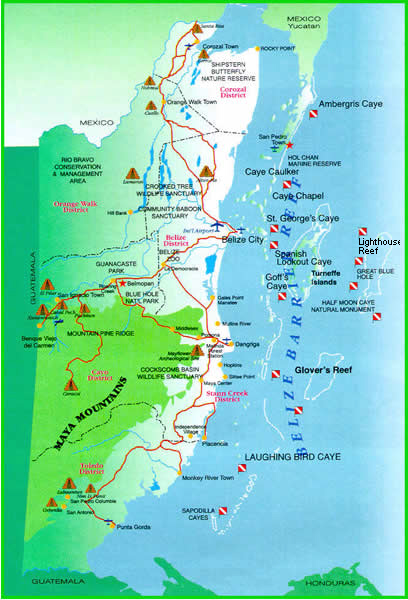 |
Belize recognizes that their tropical reefs need protection, and they have established a number of marine reserves. Snorkeling or diving in the reserves requires payment of a fee (usually US $10 per person per day), but often the snorkeling and diving in the reserves was no better than in non-reserve areas. Local fisherman are still allowed to fish in some of the reserves, and even if they are not, the reserves are often poached at night when they are unguarded. It was disappointing to find cays in reserve areas that needed cleaning up - trash on the beaches wasn't uncommon. Hopefully Belize's efforts at conservation will improve with time and experience.
San Pedro, Ambergris Cay, Belize (1/29-30). When we arrived in San Pedro, Rich went ashore to check us in with the officials and seek out some Imodium for Jan. The anchorage at San Pedro was very busy with lots of boat wakes and wasn't very comfortable, so we only spent one night here before moving further south to Cay Caulker, which was only 11½ miles away.
Cay Caulker, Belize (1/30-2/7). The pace on Cay Caulker was much slower than San Pedro, the anchorage was much calmer, and we really liked it here. Ashore, we found several good restaurants and places to enjoy a cold Belikin (the National Beer of Belize), and the locals were friendly. We found good snorkeling along the barrier reef in front of Cay Chapel, which is just south of Cay Caulker. The barrier reef in front of Cay Caulker is part of a marine reserve, so it cost $10/person/day to snorkel there. A fifteen-minute dinghy ride got us outside the park boundaries, and we could snorkel for free and do some spear fishing. Although there weren't any big fish for spearing, the grunt and schoolmaster populations were healthy, so we speared and ate those. They're tasty but small, so avoiding bones is part of the challenge of eating them.
|
|
|
|
|
|
Passage from Cay Caulker to Lighthouse Reef (2/7-2/8). After a week at Cay Caulker, we were eager to head out to Lighthouse Reef to do some scuba diving. We had to sail east to reach Lighthouse Reef, and since the trade winds generally blow from the east, we needed to wait for light winds. From Cay Caulker, we traveled to the south end of Turneffe Island (40 nm, 6 1/2 hours), where we anchored for the night, and the next day, we traveled the 20 additional miles (4 hours) to Lighthouse Reef. We were bound for the anchorage on the west side of Long Cay and had waypoints to get us safely into the anchorage. Lighthouse Reef is a coral atoll, which means it is encircled by coral. Getting into the anchorage required crossing over the reef at a point where it was about 10-15 feet below the surface. As we slowly approached the reef crossing area, Rich stood on the bow while Jan drove Slip Away. The water was so clear that it was difficult for Rich to determine how deep the water was, and at one point, he shouted to Jan to stop the boat because he was afraid we were going to hit the reef. We were in about 13 feet of water (eight feet beneath our keel), but the reef looked like it was just below the surface. We entered and anchored safely and were one of only three boats anchored at this beautiful spot.
Lighthouse Reef, Long Cay (2/8-2/26). Shortly after our arrival at Lighthouse Reef, Michael & Robin on Sea Biscuit, and Mike & Karen on Beau Soleil dinghied over to introduce themselves. Sea Biscuit and Beau Soleil were also Net Controllers for the Northwest Caribbean Net, so we had spoken a number of times on the radio, but this was our first opportunity to meet them in person. We really connected with these folks, and they quickly became good friends. Mike & Karen on Beau Soleil have sailed around the world two times, and he recently published a book Education of a Falcon telling the tales of their adventures. (Falcon is their son.) On Valentine's Day, Michael on Sea Biscuit proposed to Robin, and we celebrated their engagement.
|
|
|
We spent 2½ weeks at Lighthouse Reef, and we could have stayed longer. It was by far our favorite place in Belize. The diving and snorkeling were outstanding, and we spent lots of time in the water. Jon & Heather on Evergreen showed up at Lighthouse a few days after us, and they were great dive buddies. Belize's live-aboard dive boats spend most of their time at Lighthouse Reef, and they have set several mooring balls along Long Cay Wall, which runs along its west side. We could tie our dinghy to the mooring ball, jump in the water and dive the wall, which was covered with beautiful sponges and corals and lots of sea life. The sea temperature was a comfortable 80 degrees F, and visibility was generally 80-100 feet.
The fishing was better at Lighthouse Reef, and we enjoyed some excellent dinners of grouper, snapper and hogfish. Jon on Evergreen and Michael on Sea Biscuit were incredible spearfishermen (much better than us!). Fortunately for us, they were very generous and shared a couple of good catches with us. Lobster season was closed, so we weren't able to take those, but we didn't mind because the fish were delicious.
|
|
|
Half Moon Cay. Six miles from Long Cay at Lighthouse Reef is Half Moon Cay, the first protected area in Belize and the first marine protected area in Central America. Evergreen and Slip Away headed over to Half Moon Cay twice - this was one of the park fees we didn't mind paying.
A small area of Half Moon Cay was first established as a reserve in 1928 to protect the colony of red-footed boobies that nest on the island. There is also a large colony of frigates, and there's an observatory on the island which offers a great view of the birds nesting in the tree tops.
|
|
|
|
The bird observatory was great, but our primary reason for coming here was to dive Half Moon Cay Wall, which was outstanding. The fish were bigger and more numerous than the wall off Long Cay, and the corals and sponges were just as beautiful. We enjoyed the dive so much the first time that we went back and did it again a few days later. Jon & Heather had an underwater housing for the camera and shared their photos with us.
|
|
|
For more underwater photos, click here. (This link is repeated at the end of this page.)
Although we would have loved to stay at Lighthouse Reef for another couple of weeks, we needed to return to San Pedro to extend our tourist visas. Upon arrival in Belize, their Immigration officials gave us a visa to stay in Belize for one month. They would extend our visa two times (an additional month each time), but we needed to report into the Immigration office in order to do that.
Lighthouse Reef to San Pedro (2/26, 49 nm, 9½ hours). The entry to the anchorage at San Pedro was through a cut in the barrier reef, and we needed to arrive early in the afternoon in order to have good light to pass through it safely. Since it was a 50-mile passage from Lighthouse Reef to San Pedro, that meant leaving very early in the morning. So, the night before, we tied Slip Away to one of the dive buoys along Long Cay Wall, went to bed early and got underway at 3:30 a.m. the next morning. The trip from Lighthouse to San Pedro put the tradewinds at our back, and we had a beautiful sail.
San Pedro, Ambergris Cay (2/26-3/1). We planned to spend a few days in San Pedro this time to visit the town, pick up some provisions and do a few other errands, as well as extend our travel visa. Jan had an interesting encounter in San Pedro and was reminded how small this world is. When we arrived at San Pedro, Jan needed a hair cut. As we walked the streets, she saw a sign for a "Hair Salon & Used Books" - perfect! Rich could browse the books while she got her hair cut. The stylist, Kim, was an American woman who told Jan she moved to Belize 20 years ago - from Indianapolis (which is about 100 miles from Jan's home town of Cincinnati). Kim is now married a local guy from San Pedro. Jan was telling Kim how she had visited Belize 15 years ago with her girlfriend Lisa. Jan & Lisa did a lot of scuba diving during that visit, and Jan remembered the name of the dive shop (Tortuga Dive Center) and the names of the divemasters, Danny and Freddy, who were really nice guys. Freddy is Kim's brother-in-law; Danny is her husband's cousin. Very small world!!
|
|
|
During our time in San Pedro, one of this winter's "northers" blew through. The sea bottom in San Pedro is a hard surface covered by a thin layer of sand, and we could not get our anchor to dig in to the surface. Dragging anchor in a big blow is always a worry and even more so when it doesn't set well. However, we put out lots of chain, and the weight of our ground tackle held us through the 30-35 knot winds. There were a few other boats anchored around us, and everyone pretty much stayed put, which was quite a relief. One boat dragged probably 100 feet or so, but he didn't hit anyone, and after he dragged a bit, his anchor apparently caught on something and held him thereafter. The folks 11 miles away from us in the Cay Caulker anchorage didn't fare so well. The bottom in that harbor has a lot of sea grass, and it's also hard to get an anchor to set in that. There were 9 boats in the Cay Caulker anchorage; 6 of them dragged, a few ran into each other, and four went aground. A couple of them needed the help of a commercial towing service to get them off the beach the next day, but fortunately, there was no major damage to any of the boats. We were close enough in San Pedro to hear the excitement over the VHF radio, and we were glad to be missing it!
The primary reason for this visit to San Pedro was to get our visa extended. Visa extensions were granted at the Immigration Office - only in the afternoon - and our visa needed to be extended on a Friday afternoon. We should have known it would not go smoothly. On Friday afternoon, we showed up at 1 p.m., and the officials told us they were having a meeting and that we should come back at 3 p.m. When we came back at 3, they told us they were not going to do any extensions that afternoon, and we would need to come back on Monday. (We think the "meeting" was being held at the local bar.) We'd been in San Pedro a couple of days already, had our fill of the town, and didn't want to stay through the weekend, so on Saturday morning, we weighed anchor and sailed down to Cay Caulker. On Monday, Jan took a water taxi from Cay Caulker to San Pedro and got the visa extensions. She went to the Immigration Office early, hoping to get through the process as quickly as possible since the last water taxi back to Cay Caulker was at 3:30 p.m. By the time they started the visa extensions at 1:00 p.m., there were probably 40 people lined up and waiting. Jan was very happy to be the third person in line, and she even had time to have a beer with some folks she met in line before catching the water taxi back to Cay Caulker.
| Cay Caulker (3/1-4).
It was nice to come back here for a few days - we really like Cay Caulker. We
visited some of our favorite refreshment spots and spent some time with Bob & Maggie on Sea
Tryst, who were also there and had their son Matt and his girlfriend visiting. Bob & Maggie joined us at the
Barrier Reef Sports
Bar (aka Canadian Sports Bar) when we hung up our "Slip Away" burgee.
This time, when we left Cay Caulker, we decided to do short day sails and stop at some of the little cays that run along Belize's barrier reef. Most of the cays are mangroves and uninhabited, and with so many places to stop, there are rarely more than one or two other boats in the anchorages. The sailing breezes were pleasant, and we sailed in flat seas behind the barrier reef. |
|
St. George's Cay (3/4-5, 14 nm, 3½ hours). Most of Belize's cays are uninhabited, but St. George's is an exception. There are a number of homes on this island, as well as an R&R / Adventure Training Camp for British soldiers (most of whom were very sunburned!). There is no road on the island, but there is a pedestrian trail, and we walked along the island and found our way to a small aquarium run by a local family - Dad was German-born, mom was a native Belizean, and they had a 9 year old son "Karly" who conducted the tours of the aquarium. Karly was quite knowledgeable, very charming and made this a very worthwhile stop.
|
|
|
|
Water Cay (3/5-6, 13 nm, 3 hours). We stopped here so that we could dinghy out to snorkel "Goffs Cay", which according to our cruising guide offered excellent diving and snorkeling - but we didn't find it so impressive. About this time, Jan decided she would try her hand at spear fishing, and she shot three fish (one snapper and two grunts), so she was feeling pretty proud of herself.
Bluefield Range (3/6-7, 10½ nm, 2½ hours). Several cruisers who have anchored in the Bluefield Range told us they were visited by a couple of manatees who live there. We waited and watched for the manatees, but they didn't show up! The anchorage at Bluefield Range offers good protection from most directions, but it was open to the north, and another "norther" was on its way, so we left after one day to find better protection.
Colson Cays (3/7-9, 9 nm, 2 hours). Prior to the forecasted norther, we had strong southerly winds, so this was the one passage when we had to motor into the wind and seas to get to our next anchorage, but luckily we didn't have to go too far. We arrived at this anchorage around noon so we decided to check out another of the "excellent snorkeling" spots recommended by our Cruising Guide. The snorkeling here was pretty good, although the high winds had the water stirred up and visibility wasn't all that great. We did some spear fishing but called it quits when a curious barracuda started following us around.
An anchorage between two cays offered good protection from the impending bad weather. Our anchor set well, and we had a mangrove island in front of us to protect us from bad seas, but there wasn't much wiggle room (i.e., if we dragged, we would quickly be on the reef behind us). For some reason, storms always seem to arrive at night, and this one was no exception. By midnight, we had winds gusting in the upper 30's, and both of us were sitting up in the cockpit, unable to sleep. For about four hours during the night, we ran our engine in forward idle, which gave us some extra assurance that we wouldn't drag on to the reef behind us. When we turned on the engine, the noise of it drowned out the howling winds and must have also given us some additional peace of mind because we were then able to get some sleep (taking turns keeping anchor watch). We had two days of strong winds, and temperatures dropped into the low 70's, which was chilly to us - we got out our long pants and socks! Shortly after this cold front passed over us, Jan received some photos from her sister Judy of the snowstorm that hit Cincinnati (a foot dumped on them) - the same weather system.
Sittee Point (3/9-10, 25 nm, 5 hours). After a couple of days of strong winds, they abated enough for us to move on. We decided to move to Sittee Point, which is on the mainland of Belize, because the winds were lighter along the mainland than out along the barrier reef cays. When we left Colson Cays, we had 18-22 knots of wind, and the seas were still pretty lumpy, but as we got closer to the mainland, the winds got lighter until we finally had to motor the last couple of miles in flat calm seas. Sittee Point was a very pretty anchorage behind a wooded point, a nice change from the mangrove cays along the barrier reef.
Placencia (3/10-11, 19 nm, 3½ hours). We'd been in touch with Jon & Heather on Evergreen and decided to rendezvous with them in Placencia, a small fishing village popular with cruisers, and then head out together to Belize's Sapodilla Cays. Evergreen needed a hand completing a repair to their scuba compressor, and we needed to pick up a few provisions. This was a quick stop in Placencia for us, but we anticipated returning to spend more time there. We picked up some provisions and found the Tutti Frutti Ice Cream Shop, which serves the absolute best ice cream we've ever had. We had ice cream two times that day - the first time after lunch and then again after dinner!
Sapodilla Cays (3/11-14, ~20 nm from Placencia). Most of the Sapodilla Cays are sandy islets (different from most of Belize's other cays, which are mangroves), and our cruising guide told us that the reefs in the Sapodillas are "among the most beautiful in all of Belize." So, we were excited to visit this area and do some more diving and snorkeling. The Sapodilla Cays are part of a marine preserve, so we would have to pay a fee to visit them, but we were willing to do so. We visited Northeast Sapodilla, Lime and Tom Owens Cays. We found good snorkeling on a reef near Lime Cay (with one of the best juvenile spotted drums we've ever seen), and it was also very good at Tom Owens Cay (although the anchorage was rolly). In several other snorkel spots, visibility wasn't great and we saw a fair amount of dead coral - we found nothing compelling us to break out our dive gear. Also, the islands had trash on them (lots of plastic bottles washed up on the beaches). Overall, we were pretty disappointed.
Ranguana Cay (3/14-15, 10 nm, 2 hours). We'd heard of a number of other cruising boats stopping at Ranguana Cay, so we and Evergreen decided to check it out. Our cruising guide indicated there was some good fishing areas around Ranguana, and we were eager to find them since we hadn't fished in the Sapodillas because it was a protected area. The snorkeling and fishing were just so-so at Ranguana (we shot some grunts for dinner), so we spent one night and moved on.
Rendezvous Cay (3/15-17, 15 nm, 3 hours). Although we'd gotten a little cynical about some of the descriptions in our cruising guide, we were attracted to Rendezvous Cay, which was described as a "South Pacific-like isle with pretty white beaches lined with big shady coconut trees." As it turned out, the cruising guide was right on this one, and this was another favorite stop. Rendezvous Cay is in the Gladden Spit Region, and were we to do it over, we would have skipped the Sapodillas and spent more time visiting the cays in this area. Deep channels run between the little islets, and the blue colors of the water are stunning.
Evergreen and Slip Away anchored on the north side of Rendezvous Cay, and there were no other boats there. We dinghied a short distance to a reef extending off the south end of North Long Cocoa Cay, and the snorkeling was outstanding! The corals and sponges were healthy and colorful, and there was good fish and creature life, including a couple of nurse sharks, spotted eagle rays, slipper lobster and large crabs. Jan had an interesting experience with a remora, aka a sucker fish that normally attaches to a shark or other large fish. This one was quite enamored with Jan and wanted to attach itself to her. He followed her around for probably 15 minutes, while she tried kicking him away with her fins. She finally swam over to Rich, and although we didn't want to hurt him, we poked our spears at him to try to scare him away. He finally got the message and departed. Although having a remora attach itself isn't harmful, Jon & Heather told us they had a friend who got a big hickey from one!
We also snorkeled the south side of Rendezvous Cay, and although the visibility wasn't great, the snorkeling was pretty good, and here we found a healthy supply of conch. Conch meat is very tasty (when tenderized properly), and picking up a conch is much easier than shooting a fish! Unfortunately, conch is over-harvested in Belize, so it's rare to find more than just the occasional one. When we previously found the occasional one, we consciously decided to leave it in hopes that it might reproduce. We're not sure why there was such a good colony in this location, but we found enough to harvest some and still leave plenty to keep the colony going.
|
|
|
We could have stayed several more days at Rendezvous Cay, but more strong north winds were on the horizon, so we needed to find an anchorage with better protection. Our friends on Sea Tryst and Angelina were in Placencia, and Rich was pining for some more of the Tutti Frutti ice cream, so we headed back there.
Placencia (3/17-20, 20 nm, 4 hours). We had a beautiful sail back to Placencia, and arrived just in time for a St. Patrick's Day party. There were probably 15-20 cruising boats anchored in Placencia, and we all gathered at Yoli's, a waterfront restaurant, to celebrate with a few beers. We met several new folks at the St. Patty's Day party, and since Jan was a Net Controller, she had already talked to most of them on the radio. It was fun to put names with faces, and Jan felt like a celebrity with so many people saying "Oh, you're Jan from Slip Away!"
Upon arrival in Placencia, we mentioned to a few folks that we had picked up some conch and confessed that we didn't have a clue how to clean them. As often happens with the cruising community, we then had more offers of help than we could utilize. The next day, with a little help from our friends, we cleaned the conch. That evening, we invited Evergreen, Sea Tryst and Angelina over to Slip Away for cocktails, and Jan served up some conch chowder, which was a big hit.
|
|
|
Some cruisers seem to find Placencia "delightful" (another description from our cruising guide), but we weren't all that enamored with it. Although some of the locals were very nice (especially the folks at Yoli's), there were a few who were downright unfriendly and rude and gave us an unfavorable impression of this town. For us, the highlight of Placencia was the ice cream, and we visited Tutti Frutti's daily.
Since the end of March was approaching, we needed to think about making our way north, back to San Pedro. Our friends Jay & Danica from Virginia would be arriving there in about a week, and we were planning to meet them there. We also wanted to stop back at Rendezvous Cay for a few more days. The morning we departed Placencia, west winds kicked up and made the anchorage uncomfortable, so most of the cruising boats were weighing anchor and moving around the corner to a spot with better protection. We picked up our anchor and kept going. We had to call our friends on the radio to say good-bye instead of stopping by in person, but it was easier to do it on the radio.
Rendezvous Cay (3/20-22, 20 nm, 4 hours). The weather was overcast and cool during this second visit to Rendezvous Cay. With no sun, the snorkeling wasn't as good, but now that Rich was an expert conch cleaner, we sought out and harvested a few more. This time, we were joined at Rendezvous Cay by Orrin & Mary on Antares and George & Kathleen on Deja Vu, new friends we met in Placencia, and it was a lot of fun getting to know them better.
Passage to Cay Caulker (3/22-23, 80 nm). We had a few days before Jay & Danica were arriving in San Pedro, so we decided to sail up to Cay Caulker and wait for them there. We couldn't get all the way to Cay Caulker in one day, so we broke up the trip and stopped for the night at Middle Long Cay on our way north. The whole trip was 80 nm, and unfortunately this was one of those times when the winds were either on our nose or too light to sail, so we had to motor.
| Cay Caulker (3/23-3/28).
Since we like Cay Caulker, we didn't mind at all hanging out and waiting here
for our friends. Although we had some boat chores to
work on, socializing seemed to take priority over them. Shortly after
arriving in Cay Caulker, we heard a familiar voice on the radio - Claude from
Wapiti. We met Claude and his wife Claire last year in Isla Providencia. (Claude and
Claire are French, and we recalled and laughed about how Claire thought "Slip
Away" meant something to do with taking off your underwear since "slip" means
underwear in French.) It was so much fun to see them again! Antares and Deja
Vu showed up in Cay Caulker a couple days after us, so we spent some more time with them,
as well as John on Chancey, whom we also met in Placencia.
We also made some new friends here - Chris & Laura on Divocean - in an unusual way. One morning at about 5:30, we were awoken by a noise - it sounded like something was scraping against our hull. We jumped out of bed to find Divocean (a large catamaran) banging against our starboard side. The wind was blowing fairly strong, their anchor had dragged, and as they were dragging by us, a line on their deck caught on our spare anchor on the bow pulpit. Rich pushed Divocean away from Slip Away as Jan unhooked them from us. Chris quickly got their engine started, pulled away from us and re-anchored. Later that morning, they came by with a bottle of wine and apology, which we tried to assure them was not necessary - there was no damage done, and $hit happens. (In the previous big blow in Cay Caulker when so many of the boats dragged, Divocean was one of the few that didn't.) We ended up going over to Divocean for cocktails the next evening - very nice folks! |
|
| Cruising with Always & All Ways
(3/28-4/3). We were very excited that our friends Jay & Danica were coming
to Belize. We cruised with Jay & Danica both in the Pacific and
Caribbean (their boat name is Alkahest), and last summer and fall, we spent quite a bit
of time with them in southern Virginia where they are now working. They chartered a catamaran
(Always & All Ways) with some friends from the
Seattle area (where they used to live), and we planned to spend a few days with
them before we returned to Mexico. The timing for running into Wapiti was
also quite fortuitous because Alkahest, Wapiti and Slip Away all met last year
in Panama.
Since Jay & Danica were cruisers, they were well aware that we would be asking them to bring us a couple of packages, and they happily obliged. While we were in Rendezvous Cay, our camera started showing signs of dying, so we ordered a new one on-line and had it and an underwater housing shipped to them. We were envious of Evergreen's underwater photos, and wanted to be able to take some, too. They also brought us our mail and a few special snack treats which we couldn't get in Belize. Yum! We sailed to San Pedro to meet up with Jay & Danica and their friends, and we had some good times with them over the next few days. We shared anchorages (San Pedro, Cay Caulker and Shag Bluff), sailed, snorkeled and quaffed a few rum drinks. While at Shag Bluff, Rich had an interesting spearfishing experience. He was snorkeling with his spear and saw a nice-sized grouper. It was under the reef, and he took a shot at it - a perfect brain shot that killed it immediately. As he tried to bring the speared fish out from under the reef, he felt like he was having a tug of war. When he looked under the ledge of the reef, he saw a large green moray with the grouper in its mouth - only the head of the grouper was still visible. The moray eel got the fish, and we had chicken for dinner that night. |
|
After a couple of days with Always & All Ways, they continued south, eager to find Rendezvous Cay after hearing so much about it from us. We needed to go north, so we parted ways. When Always & All Ways took off, Slip Away and Wapiti headed to the Bluefield Range, and we shared dinner with Claude & Claire one last time before heading off. Once again, the manatees in the Bluefield Range hid from us, but Claude & Claire reported that they saw them several times the next day after we left.
| Return to Mexico. We
had already done our check-out paperwork with the Belizean officials, so we
needed to get on our way. From the Bluefield Range, we sailed back north to
Cay Caulker, where we spent the night, and very early the next morning, we weighed anchor
intending to go to Xcalak, Mexico's southernmost Caribbean port of entry, about
35 miles away.
As we were sailing north from Cay Caulker, we got a call from a boat named
Spray, who had just visited Xcalak. Winds were forecasted to
build to 20 knots from the east that night, and he advised us that the cut in
the reef at the entrance to Xcalak would be too dangerous to transit in those
conditions. He recommended that we instead go to Bahia Asencion, where the
entrance is wide open and navigable in any conditions. We thanked him for
the information, and changed our plans.
Bahia Asencion was 130 nm away - an overnight trip - and in order to arrive in daylight hours, we needed to delay our departure. So, we stopped in San Pedro, dropped our anchor and hung out for about four hours. While we were anchored in San Pedro, a dinghy stopped by, and the familiar face of Charles from Blue Moon greeted us. Blue Moon and Slip Away had sailed past one another a few days earlier, and Wapiti reminded us that we had met Blue Moon at Isla Providencia (Columbia) last Spring. Blue Moon and Slip Away ended up buddy-boating from San Pedro to Bahia Asencion (although Blue Moon left a few hours after us because he has a faster boat), and over the next couple of weeks, we shared several anchorages and spent quite a bit of time together. The passage from San Pedro to Bahia Asencion took us 21 hours. The seas were a bit lumpy, but we had favorable winds, and sailed the whole way. Bahia Asencion / Punta Allen, Mexico (4/4-7). When Bob on Spray recommended that we divert to Bahia Asencion, he told us that he and his wife had spent a couple of weeks there waiting for favorable weather to continue south. They didn't mind, though, because they really enjoyed the small town at Punta Allen. The winds blew pretty hard while we were at Punta Allen, but the anchorage was well protected. We enjoyed Punta Allen, but found it to be very expensive - obviously influenced by the influx of tourism from Cancun. |
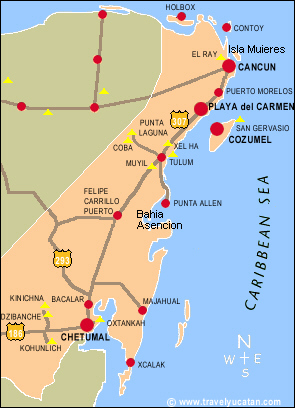 |
We shared this anchorage with Charles & Russ on Blue Moon and Doug & Marissa on Bacchanal. Blue Moon's captain is Charles from Zurich, Switzerland. Charles' wife doesn't like to cruise as much as he does, so she sometimes takes a break, and when she's off the boat, he picks up a crew member to help him. Russ, a Canadian in his mid 30's, was crewing for him at the time. They met through crew finders, an organization that helps captains and available crew persons find one another. Doug and Marissa on Bacchanal are a young Australian couple (we'd guess in their late 20's), taking a break in their careers to cruise for a couple of years. We were quite a diverse group, and it was fun spending time with these folks.
Bahia Asencion to Cozumel (71 nm, 11¼ hours). When we left Bahia Asencion, we had some big plans. Our old neighbors from Santa Monica, California - John & Joann Flynn - would be arriving on the island of Cozumel in a few days to visit their son John, Jr. and his family, who live there. We were planning a little "vacation" in conjunction with John & Joann's visit - we were going to put Slip Away in Puerto Aventuras Marina on the mainland, take the ferry to Cozumel, and stay in a hotel for a few nights. We'd heard the anchorage at Cozumel wasn't all that great, and since we'd been very frugal over the winter, we thought this would be a nice treat. We were also looking forward to scuba diving at Cozumel, one of the top dive destinations in the world, and we were eager to try out our new camera and underwater housing. John Jr. is President of Sand Dollar Sports, which is the largest water sports company on Cozumel, and he offered to set us up to scuba dive with his company - very nice!
We were able to sail all the way up to Puerto Aventuras, with a pleasant 10-12 knot breeze and the strong current carrying us along. The seas were a little lumpy - they hadn't laid down from the strong winds of the past few days, and there was a fairly large swell running from the southeast. We even caught a fish - we were so excited when our fishing line went off! But then, we were disappointed to find that it was a sailfish (not great for eating), so we needed to release him, which we managed to do without harming him, but we also ended up losing our lure.
When we got outside Puerto Aventuras marina, Mother Nature proved once again that she was in charge. The entrance to Puerto Aventuras is narrow, so the marina usually sends out a small boat to follow in. We called the marina manager to let him know we had arrived, but he advised us the seas were too rough for us to come in the entrance. He recommended that we go anchor at Cozumel (11 miles away) and get in touch with him the next day to see if things settled down. The seas didn't lay down for several days, so we were not able to get into the marina, and we stayed anchored at Cozumel.
| Cozumel (4/7-4/13).
Cozumel is the largest of Mexico's Caribbean Islands (32 miles [52 km] north to
south and 9 miles [14 km] east to west), and it is located about 11 miles (18
km) off the coast of Mexico's Yucatan peninsula. During the Mayan era, the
island was a sanctuary for Ixchel, the goddess of fertility, and a
destination for religious pilgrimages. Cozumel has beautiful underwater
reefs lying off its shores. Jacques Cousteau visited the island and dove
its reefs in the 1950's, and thereafter it's reputation spread as a world-class
dive site. Tourism is king in Cozumel - in addition to scuba diving, it is
a popular stop for cruise ships - and today, the island welcomes more than 2 million
visitors annually.
Jan had visited and dove at Cozumel several times in the past. Her first visit was in 1986, but she had not been back since 1997, when Rich came with her, shortly after he got his scuba certification. Jan saw a lot of growth and changes in the island with each visit, but the most dramatic changes occurred since her last visit. The island exhibits much more affluence now as a result of its successful tourism business, but the display of wealth is not garish and the island is not overrun with high-rise hotels. Cozumel is no longer the quaint little Mexican island that Jan found in the 1980's, but the locals are still friendly and it's still a nice place to visit. John Jr. and his wife Angelica credited their mayor for giving Cozumel the face lift it needed and also for instilling pride in the local people. Cozumel was devastated by Hurricane Wilma in 2004, and within days, the mayor had all the locals out in the streets cleaning up their island - they didn't just sit around and wait for help to arrive. From what we understand, FEMA visited Cozumel afterward to take some notes on their quick and successful recovery. While we were in Cozumel, a new mayor was coming into office - it sounds like he's got some big shoes to fill. |
|
Upon arrival in Cozumel, we needed to check in with the local officials. Although we had already been in Mexico for a few days, there was no Port Captain or Immigration in Bahia Asencion, so we needed to visit them here. We'd heard that checking in at Cozumel could be a big hassle, but we found it pretty easy. We dealt with a couple of different guys at the Port Captain's office, and both were very pleasant and helpful. We needed to make a trip to the airport to visit Immigration and the Health Department, but we were able to walk there. The Health Department guy was the only grump of the group, but in the end, he just asked us if we had any diseases, and when we said "no", he stamped our paper, and sent us on our way. When we returned to the Port Captain's office with the required stamps from Immigration and the Health Department, it was late afternoon, and the official suggested that we come back the next morning to finish our paperwork because if we did it that afternoon, he would have to charge us overtime. How nice!
We arrived in Cozumel a couple days ahead of schedule, so our friends John & Joann had not yet arrived, although they would be there shortly. We called John Jr. to let him know of our change in plans, and he met us and took us around to show us his company, meet his employees and set us up for diving. His employees were very friendly and helpful and treated us like part of the family. We did six dives with Sand Dollar Sports (two dives per day over three days), and the diving was great - beautiful coral formations and clear blue water.
We also had some quality time to spend with John & Joann, which was a nice treat because the last time we saw them was our going away party in 2003! We enjoyed meeting and spending time with John Jr.'s family - wife Angelica, and kids Tamara and Juan Diego. John Jr. & Angelica built a beautiful home on Cozumel (John had prior experience in construction), and they made us feel very welcome. We look forward to visiting them again!
|
|
|
|
|
|
|
In the end, staying on Slip Away at anchor worked out just fine. Cozumel's anchorage is an open roadstead, but the southeast swell that closed the Puerto Aventuras marina entrance was blocked by the island, and the weather was settled, so we could sleep at night without rolling around too much. Also, the clear blue water in Cozumel's anchorage was probably some of the prettiest we've ever anchored in. Cozumel's harbor is very busy with lots of wakes from local boats, so it wasn't much fun to be on Slip Away during the day. One day there were eight cruise ships in port - the boat traffic from shuttling all those tourists around was incredible! We stayed ashore that day until most of the cruise ship folks were back on their boats and the shuttle boat traffic calmed down.
Punta Maroma (4/13-4/17, 14 nm, 2¼ hours). We reluctantly left Cozumel on a Sunday morning because some bad weather was on the way, and we needed to find a more sheltered anchorage. Sunday is the only day when there are no cruise ships in port, and it would have been nice to see the town on its "day off." However, Cozumel's anchorage was no place to be in a norther, and we weighed anchor and motored over to Punta Maroma (aka Hut Point) on the mainland.
Punta Maroma lies about 40 miles south of Cancun, and development from Cancun is encroaching on the area. We anchored south of the point and there were a hotel and marina built on the beach. When we walked north along the beach and rounded the point, we found the beach lined with resorts. We decided the hotel near our anchorage must have been built for honeymooners, because in addition to beach chairs, they had beach-side beds! The tourist excursions from the marina offered us quite a bit of entertainment. A couple of times each day, jet-ski and small motor boat tours took off, with a leader and all the jet-skis or motor boats following in a line behind. (Although we chuckled at the tourists following the leader around on the jet skis, we much preferred that to jet skis running amuck through the anchorage and doing donuts around Slip Away.) We saw the same type of tour on land with little land-rover ATVs.
This turned out to be quite a good anchorage during the bad weather. In fact, the weather wasn't so bad here at all, but the wind was blowing from the north, so we needed to wait until the weather was more favorable for us to travel north to Isla Mujeres. Blue Moon was also anchored here during this time, and we enjoyed some good times with Charles & Russ, sharing drinks and meals and playing games of Dominoes and Farkle.
|
|
|
|
| Passage to Isla Mujeres (4/17, 43
miles, 7½ hours). When the north winds abated, we left the shelter of Punta Maroma
and headed for Isla Mujeres. The seas were very big and confused during
the first 10-12 miles of the trip due to the convergence of
strong currents in this area. Shortly after passing Puerto Morelos, the current
diminished quite a bit and the seas calmed down significantly. The wind still
had a northerly component to it, and it was a bit too close for us to sail, so
we ended up turning on the engine and motor sailing. The Yanmar sure makes
it easier to sail close hauled! We caught a barracuda on our fishing lines
just before arriving in Isla Mujeres, but we threw him back because he was too
big. Barracuda can be good eating, but we were advised not to keep any
over two feet long because they could carry ciguatera poisoning.
Darn!!
Isla Mujeres (4/17-4/26). It was good to be back in Isla Mujeres, where we would wait for a weather window for our crossing to Key West, Florida. We had a number of errands to run and chores to complete before our crossing, not the least of which was purchasing a sufficient supply of Rich's blood pressure and cholesterol medications to last him until we returned here next winter. Those medications are less expensive and available over the counter in Mexico - we found the best prices at WalMart in Cancun. We filled up our fuel tanks (diesel was only $2.15/gallon here), changed engine oil and worked on a couple other boat chores. We also enjoyed a busy social schedule, visiting again with our friend Paul, as well as several new cruising friends. We especially enjoyed meeting Rebecca and Patrick on Brick House - Patrick sailed around the world in the 1970's on a Catalina 27, which is the same type of sailboat we owned prior to buying Slip Away. |
|
|
When the weather forecast looked favorable, there was a fleet of six boats waiting to go - Altair, Blue Moon, Reverie, Sun Dazzler, Sweet Bess, & Slip Away. The day before departure, we gathered together to discuss strategies and establish a radio check-in schedule. Jan had given up her position as Net Controller for the Northwest Caribbean Net, but she took on the job of getting position reports from each boat in the fleet and reporting to the Net for all of us. Tom on Reverie is an Oceanographer, and he helped us identify a favorable route to take advantage of the push from the Gulf Stream. How lucky is that to have an Oceanographer in the group!
|
|
|
Isla Mujeres to Dry Tortugas (4/26-4/28, 288 nm, 55 hours). We left Isla Mujeres early on a Saturday morning. We had winds on the nose at the start of the trip, so we had to motor, and the seas were pretty rough, but as we got further along, the winds and seas got calmer, and then the winds direction veered to a more southerly direction and built to 10-15 knots, and we finished the trip with a nice sail. All told, we motored 33 1/2 hours and sailed 21 1/2. The fish were not biting - we didn't even get a nibble!! When we left Isla Mujeres, we were undecided as to whether we would go all the way to Key West or stop at the Dry Tortugas, islands about 70 miles west of there. As we were closing in on our destination, the timing was such that stopping at the Dry Tortugas would allow us to make landfall in daylight hours, but if we went on to Key West, we'd get in after dark. We were wanting at some point to visit the Dry Tortugas, which is a National Park, so this looked like a good opportunity. We dropped our anchor at the Dry Tortugas mid-afternoon on Monday. The anchorage was quite crowded, but we found an open space. The open space was in front of Tiburon, a power boat with a very large man on board, who immediately started screaming at us that we were anchoring too close to him. What a nice welcome back to the USA! No wonder this space was open! Jan spoke to this rather unpleasant fellow on the radio and politely told him to "hold his horses" - we would launch our dinghy and check the depths in front of us with our hand-held depth sounder to see if we could move further away. There were some very nice people on another sailboat, who saw and heard all this commotion, and they also called us on the radio and asked us to stop by when we got our dinghy launched. They let us know that they thought there was probably enough depth in front of us to move further forward. We checked it out, and the depth was good, so we moved forward and away from the screaming maniac. About an hour later, another sailboat arrived in the anchorage, and since there was a open space between us and Tiburon, they anchored there. Needless to say, they too got an earful, and they moved away from him and next to us. Altair, Reverie and Sun Dazzler also stopped in the Dry Tortugas, and we helped them to find good anchoring spots well away from Tiburon. |
|
In spite of the rather unfriendly welcome we received, it was good to have this passage behind us, and we were looking forward to cruising the summer along the East Coast of the U.S.
For more underwater photos, click here.
